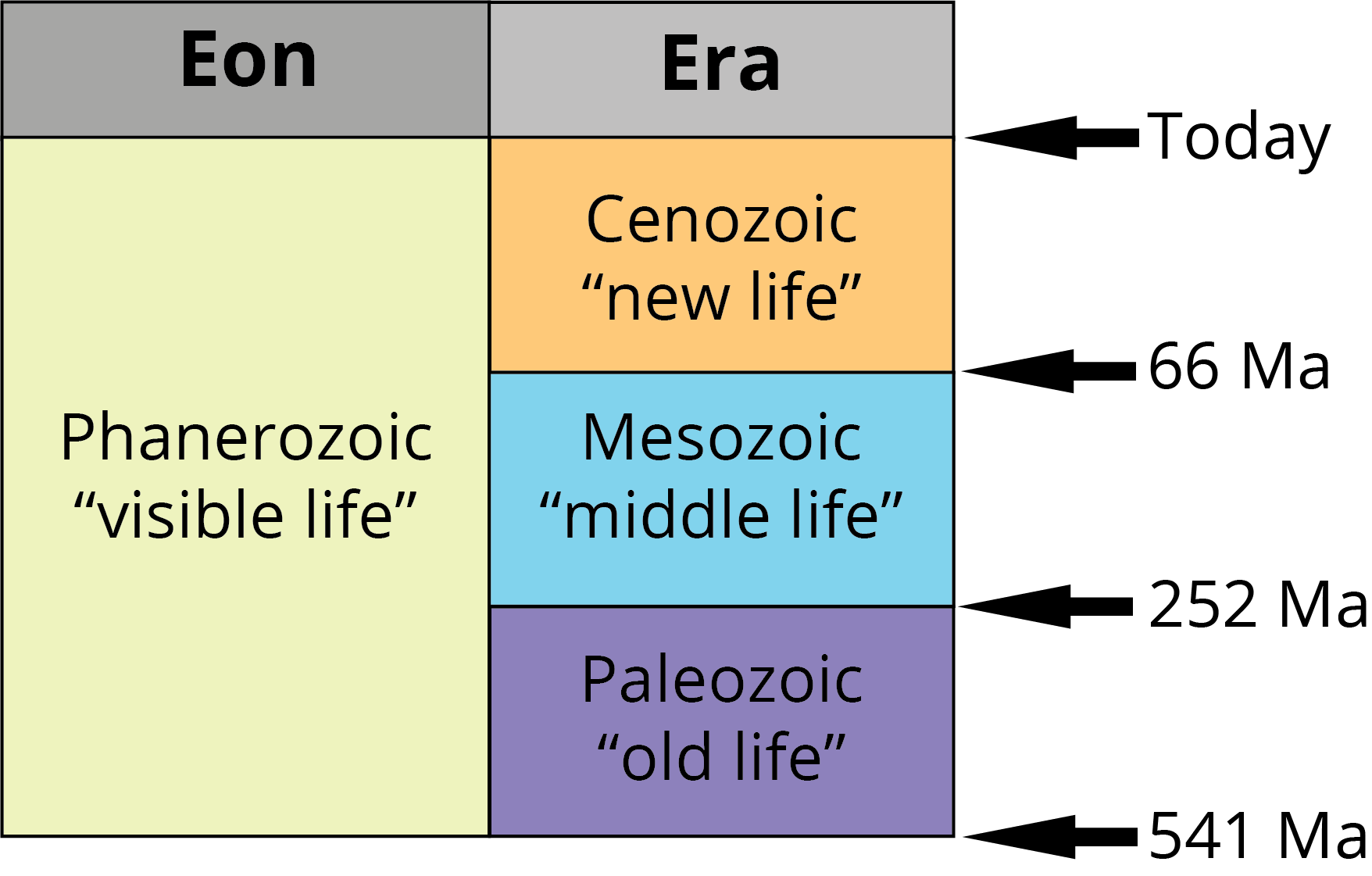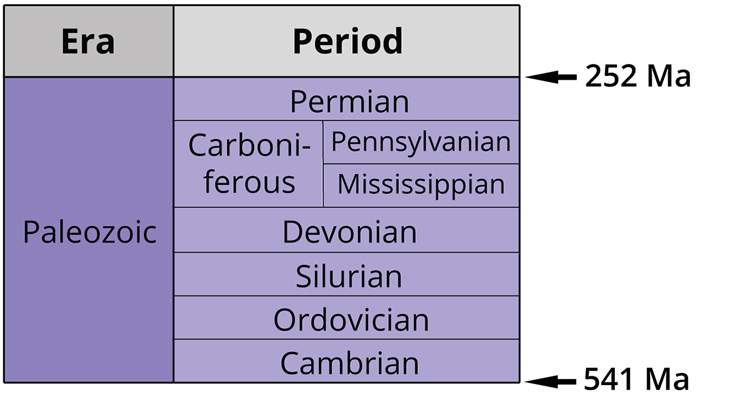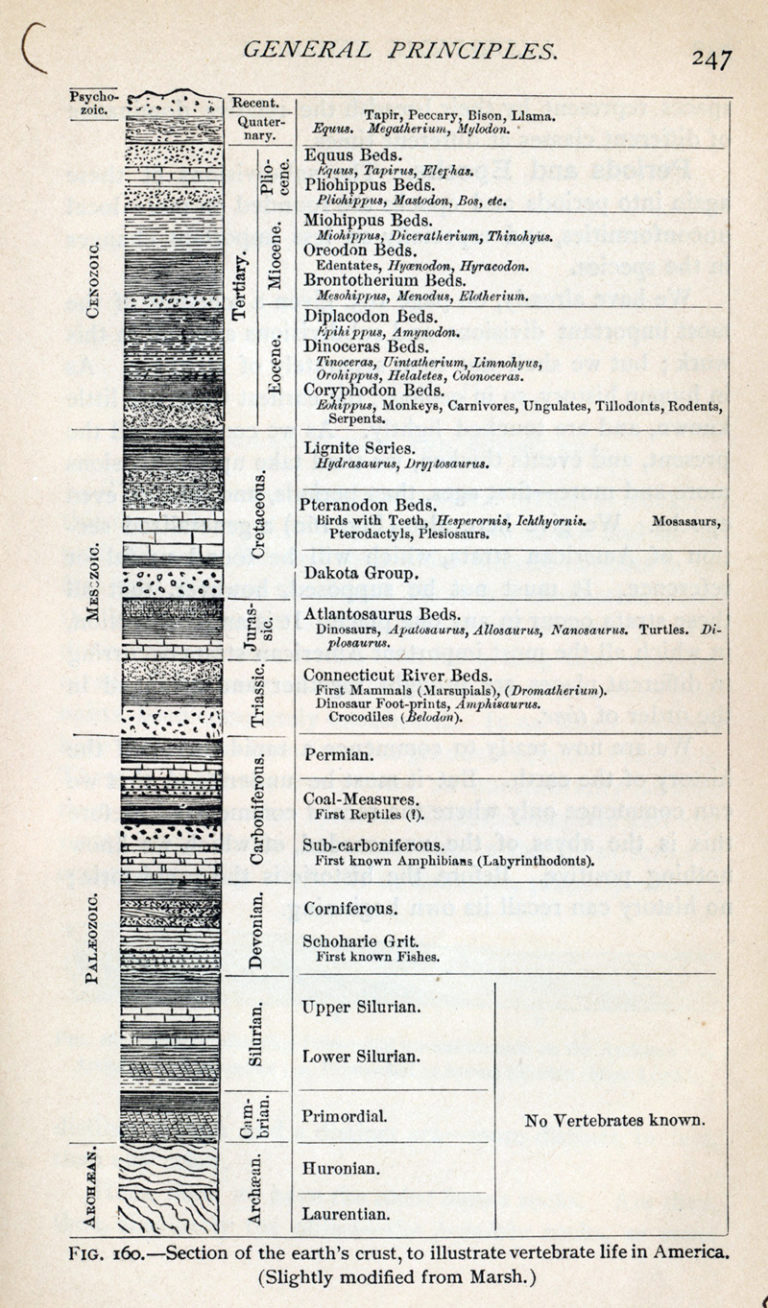7.4: The Geological Time Scale
- Page ID
- 22641
The geological time scale is one of the crowning achievements of science, and geology in particular. It is a reference and communication system for comparing rocks and fossils from throughout the world and is geology’s equivalent of the periodic table of the elements.
The geological time scale is currently maintained by the International Commission on Stratigraphy (ICS), which is part of the International Union of Geological Sciences. The time scale is continuously being updated as geoscientists learn more about the timing and nature of past geological events. You can view the ICS time scale online.
The geological time scale provides a global summary of countless small-scale temporal correlations of rock layers made at local and regional scales. It is based almost entirely upon careful observations of the distributions of fossils in time and space. The dates were added much later following the advent of numerical dating techniques giving us the ability to bracket the ages of different organisms in relation to numerical dates provided by associated igneous activity.

Time scale history
William Smith used the principle of faunal succession and correlation to great effect in his monumental solo project to create a geological map of England and Wales, published in 1815. Inset into Smith’s great geological map is a small diagram showing a schematic geological cross-section extending from the Thames estuary of eastern England all the way to the west coast of Wales. Smith shows the sequence of rocks, from the oldest (Paleozoic age) rocks of Wales and western England, through the middle aged (Mesozoic) rocks of central England, to the youngest (Cenozoic age) rocks of the area around London. Smith did not put any numerical dates on these because he didn’t know them. But using the principle of superposition and faunal succession he knew that, when tipped upright, this diagram represented a stratigraphic column, a sequence of rock in order from oldest, on the bottom, to youngest, at the top. And because almost every period of the Phanerozoic is represented along that section through Wales and England, it is a primitive geological time scale.

The simple principles of superposition and faunal succession have provided geologists with the ability to reconstruct the geological history of Earth by correlating rocks and fossils from different places. This is critically important because no single place on Earth preserves a complete geological history, or even a small fraction of it. We only get a sense of the full story if we look everywhere, using multiple locations to piece together the puzzle of snapshots of the Earth through time.
The geological time scale provides a global summary of countless small-scale correlations of rock layers made at local and regional scales. It is based almost entirely upon careful observations of the distributions of fossils across time and space.
Another important principle of relative dating, the principle of faunal succession, which is the concept that fossils can occur in predictable sequences because of the time intervals in which they exist. Fossils can act as “timestamps” that reveal the age of the strata in which they are found.
Early on in this chapter we discussed the work of William Smith (1769 – 1839) as one of the founding fathers in our early understanding of geologic time in the 1700s and early 1800s. Smith’s work in understanding early relative dating principles of superposition and faunal succession set the stage for the definition and naming of the periods of geologic time. British geologists initiated this task around 1820. Later, geologists from other European countries joined them. Many of the periods are named for places where rock of that age are found in Europe. A full list of meanings for all of the geologic time periods is found below.

Learning the geological time scale
Because of its usefulness for communicating about events in Earth’s history, it is important that all students of geology, paleontology, and evolutionary biology commit the geological time scale to memory. This is most easily done by first breaking the time scale into its component parts: eons, eras, periods, and epochs.
Eons
The eon is the broadest category of geological time. Earth’s history is characterized by four eons; in order from oldest to youngest, these are the Hadean, Archean, Proterozoic, and Phanerozoic. Collectively, the Hadean, Archean, and Proterozoic are sometimes informally referred to as the “Precambrian.” (The Cambrian period defines the beginning of the Phanerozoic eon; so, all rocks older than the Cambrian are Precambrian in age.)
We live during the Phanerozoic, which means “visible life.” This is the interval of geological time characterized by abundant, complex fossilized remains. Being the youngest eon of time, it is also very well represented by rock at Earth’s surface (because of the Principle of Superposition). Because of these two factors, most paleontologists and geologists study fossils and rocks from the Phanerozoic eon.
Do not let the time scale at the top of this page give you a false impression, however, about the temporal duration of the Phanerozoic eon relative to the three older Precambrian eons. Note in the figure below the absolute ages of the boundaries separating each eon of time.

You have already learned that the Earth is 4.56 billion years old. The Phanerozoic eon began 541 million years ago (or, 0.541 billion years ago). Thus, the Phanerozoic eon represents a paltry 12% of Earth’s history! Instead, most of Earth’s history is represented by the three Precambrian eons. These older eons tell the story of Earth’s beginning, life’s origin, and the rise of complex life.
The Hadean and Archean are difficult eons to study, however, because they are exposed in very limited places on Earth’s surface. (Since they are the oldest eons, rocks that are Hadean and Archean in age are often buried far below younger rocks at Earth’s surface.) Proterozoic rocks–which span nearly 2 billion years (42% of Earth’s history)–are much more accessible, but, until recently, have received significantly less attention from paleontologists than rocks from the younger, fossil-rich Phanerozoic eon. That is slowly beginning to change, however, as more clues about the origins of complex life begin to be revealed from Proterozoic-aged rocks.
Eras
Eons of geological time are subdivided into eras, which are the second-longest units of geological time. The Phanerozoic eon is divided into three eras: the Paleozoic, Mesozoic, and Cenozoic.

Most of our knowledge of the fossil record comes from the three eras of the Phanerozoic eon. The Paleozoic (“old life”) era is characterized by trilobites, the first four-limbed vertebrates, and the origin of land plants. The Mesozoic (“middle life”) era represents the “age of dinosaurs,” though also is noteworthy for the first appearances of mammals and flowering plants. Finally, the Cenozoic (“new life”) era is sometimes called the “age of mammals” and is the era during which we live today.
As temporal points of reference, it is worth memorizing the ages of the boundaries that separate the three eras of the Phanerozoic eon. Long before geologists knew these absolute age dates, they realized that the boundaries represent important events in the history of life: mass extinctions. For example, many fossils that are commonly found in the youngest Paleozoic rocks are not found in overlying Mesozoic rocks. Similarly, dinosaur fossils found in the youngest Mesozoic rocks are never again found in the overlying Cenozoic rocks. Paleontologists and geologists used these mass extinction events to define these (and other) boundaries within the Phanerozoic portion of the geological time scale. It is therefore no coincidence that some of the major boundaries coincide with mass extinction events!
The older Archean and Proterozoic eons are similarly divided into several eras. For example, the youngest era of the Proterozoic eon is called the Neoproterozoic. For the sake of simplicity, these older eras are not included on the time scale shown at the top of this page; they do, however, exist!
Periods
Just as eons are subdivided into eras, eras are subdivided into units of time called periods. The most well known of all geological periods is the Jurassic period of the Mesozoic era (the movie Jurassic Park, of course, has something to do with that).
The Paleozoic era is divided into six periods. From oldest to youngest, these are the Cambrian, Ordovician, Silurian, Devonian, Carboniferous, and Permian. Note that in the United States, the Carboniferous is divided into two separate periods: the Mississippian and the Pennsylvanian.

The Mesozoic era is divided into the Triassic, Jurassic, and Cretaceous periods.

Finally, the Cenozoic era is divided into three periods: the Paleogene, Neogene, and Quaternary.

Epochs and Ages
Periods of geological time are subdivided into epochs. In turn, epochs are divided into even narrower units of time called ages. For the sake of simplicity, only the epochs of the Paleogene, Neogene, and Quaternary periods are shown on the time scale at the top of this page. It is important to note, however, that all of the periods of the Phanerozoic era are subdivided into the epochs and ages.
The Paleogene period is divided into–from oldest to youngest–the Paleocene, Eocene, and Oligocene epochs. The Neogene is divided into the Miocene and Pliocene epochs. Finally, the Quaternary is divided into the Pleistocene and Holocene epochs. Some geologists now think that–since humans are having such a notable impact on the Earth and its life–a new, youngest epoch should be added to the Quaternary: the Anthropocene. There is still considerable discussion in the geological community about whether this epoch should be added, as well as debate about what characteristics should define its beginning.

Interacting with The Geological Time Scale
Spend some time getting to know the major events in the history of the Earth through this interactive Earth Viewer. Select “Info” and “Tutorial” to understand the full range of capabilities of this interactive to look at Earth throughout geologic time. The interactive opens on the Phanerozoic Eon; you can select “Ancient Earth” to view the globe and events of the Proterozoic Eon. The geologic time scale appears at the left with a silver slider that you can grab and peruse through time past. Select “View” to see overlays available for the globe and the time scale. The layer selected in the static image below is “Mass Extinctions.” Note how these correspond with the end of Eras and Periods during the Phanerozoic Eon (small yellow triangles). This view is focused on North America at the end of the Mesozoic Era which culminates with the mass extinction event of the dinosaurs.

Now that you have learned about the hierarchical components of the geological time scale–eons, eras, periods, and epochs–consider again how all of these parts fit together. Note that some boundaries (those that follow horizontal lines on the time scale) are equivalent in age. For example, the Mesozoic-Cenozoic boundary is equivalent to the Cretaceous-Paleogene boundary (both have an age of 66 Ma). Similarly, the Paleogene-Neogene boundary is equivalent to the Oligocene-Miocene boundary.
It is much easier to memorize the time scale by first breaking it down into its component parts. Many geology students have developed clever mnemonic devices to help remember all of the names in the time scale and a quick Google search will provide many examples (which are often rather salty!) that you may find helpful as you memorize the time scale.

The geological time scale is a result of hundreds of years of investigation and remains very much a work in progress. Observe the geological time scale below, which is from a college-level geology textbook published in 1885 by geologist and conservationist Joseph LeConte (1823-1901) from the University of California, Berkeley. Many similarities exist with that presented above. Differences primarily exist with the oldest Eons. Our understanding of the occurrence, ordering and evolution of the species through time was remarkable even though the study of geology and paleontology was little more than a century old.



